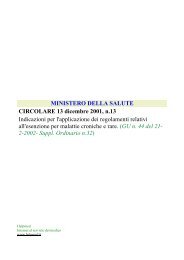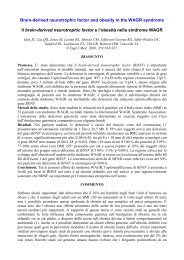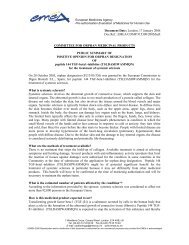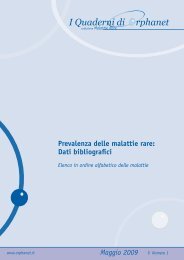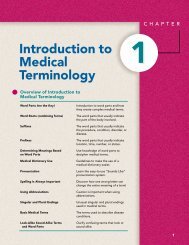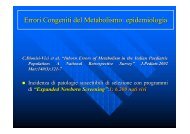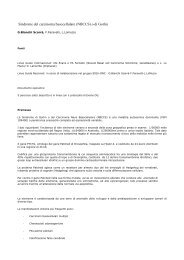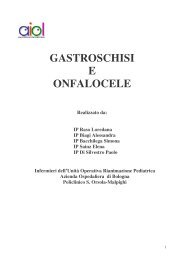La sindrome da Iper-IgD e altre sindromi - Malattie metaboliche.it
La sindrome da Iper-IgD e altre sindromi - Malattie metaboliche.it
La sindrome da Iper-IgD e altre sindromi - Malattie metaboliche.it
Create successful ePaper yourself
Turn your PDF publications into a flip-book with our unique Google optimized e-Paper software.
RASSEGNA<br />
Le febbri periodiche sono febbri ricorrenti, che<br />
durano <strong>da</strong> qualche giorno ad alcune settimane,<br />
con intervalli asintomatici di durata variabile.<br />
Le cosiddette <strong>sindromi</strong> autoinfiammatorie sono disordini<br />
sistemici caratterizzati <strong>da</strong> infiammazione<br />
apparentemente spontanea, in assenza di autoanticorpi<br />
ad alto t<strong>it</strong>olo o linfoc<strong>it</strong>i T antigene-specifici<br />
(1). A queste appartiene la <strong>sindrome</strong> <strong>da</strong> <strong>Iper</strong>-<strong>IgD</strong><br />
(Hyper-<strong>IgD</strong> Syndrome: HIDS).<br />
<strong>La</strong> <strong>sindrome</strong> <strong>da</strong> <strong>Iper</strong>-<strong>IgD</strong> ha ricevuto dign<strong>it</strong>à nosografica<br />
di nuova malattia nel 1984 per mer<strong>it</strong>o di<br />
Drenth, di Van der Meer e dell’International Hyper-<strong>IgD</strong><br />
Study Group (2-4). È stata anche descr<strong>it</strong>ta<br />
come una variante del morbo di Still (5-6) o come<br />
febbre <strong>da</strong> etiocolanolone (7). L’anno successivo<br />
è stato pubblicato un nostro case report (8) relativo<br />
ad una ragazza di 25 anni con episodi feb-<br />
Reumatismo, 2004; 56(3):147-155<br />
<strong>La</strong> <strong>sindrome</strong> <strong>da</strong> <strong>Iper</strong>-<strong>IgD</strong> e <strong>altre</strong> <strong>sindromi</strong> febbrili<br />
periodiche ered<strong>it</strong>arie<br />
Hyper-<strong>IgD</strong> syndrome and hered<strong>it</strong>ary periodic fever syndromes<br />
R. Scolozzi, A. Boccafogli, L. Vicentini<br />
Centro di ricerca e servizi per lo studio delle malattie allergiche, Azien<strong>da</strong> Ospe<strong>da</strong>liera Univers<strong>it</strong>aria di Ferrara<br />
SUMMARY<br />
Hered<strong>it</strong>ary periodic fever syndromes are a group of systemic disorders characterized by recurrent attacks of systemic<br />
inflammation (autoinflammation) w<strong>it</strong>hout infectious or autoimmune cause.<br />
The hyper-<strong>IgD</strong> syndrome (HIDS) is a rare autosomal recessive inflammatory disorder characterized by recurrent fever,<br />
increased serum <strong>IgD</strong> (normal value < 100 U/ml) and generalized inflammation (lymphadenopathy, arthralgias/arthr<strong>it</strong>is,<br />
abdominal complaints, skin rash, and hea<strong>da</strong>che). The attacks persist during the entire life although frequency and<br />
sever<strong>it</strong>y tend to diminish w<strong>it</strong>h age. HIDS is caused by specific mutations in the gene encoding mevalonate kinase, resulting<br />
in depressed enzymatic activ<strong>it</strong>y. At present the therapy for the syndrome is only supportive.<br />
Other than HIDS, other hered<strong>it</strong>ary systemic inflammatory disorders have been described: the Familial Med<strong>it</strong>erranean<br />
Fever, the tumour necrosis factor receptor associated periodic syndrome (TRAPS), a disease related to the mutations<br />
of one of the TNF receptors, the Familial Cold Urticaria and the Muckle-Wells syndrome. The differential diagnosis<br />
w<strong>it</strong>h other causes of periodic fever is crucial for assessing appropriate management and treatment.<br />
Indirizzo per la corrispondenza:<br />
Prof. Rosario Scolozzi<br />
Centro Allergologico, Sezione di Clinica Medica<br />
Azien<strong>da</strong> Ospe<strong>da</strong>liera Univers<strong>it</strong>aria di Ferrara<br />
Corso Giovecca 203, 44100 Ferrara<br />
E-mail: slr@unife.<strong>it</strong><br />
Reumatismo, 2004; 56(3):147-155<br />
brili ricorrenti iniziati all’età di due anni, iper-<strong>IgD</strong><br />
sierica, rapporto k/λ invert<strong>it</strong>o nelle <strong>IgD</strong> di membrana,<br />
risposta proliferativa dei linfoc<strong>it</strong>i B lievemente<br />
depressa a tre m<strong>it</strong>ogeni policlonali ed inversione<br />
durante gli attacchi febbrili del rapporto<br />
CD4+/CD8+, con ripristino del valore normale nei<br />
periodi intercr<strong>it</strong>ici.<br />
Il registro delle HIDS di Nijmegen (Olan<strong>da</strong>) riporta<br />
i <strong>da</strong>ti clinici di 170 casi, pubblicati e non: la<br />
maggior parte è di razza bianca e proviene <strong>da</strong>i paesi<br />
europei occidentali; circa il 60% sono olandesi<br />
o francesi (9).<br />
QUADRO CLINICO E LABORATORISTICO<br />
L’HIDS è caratterizzata <strong>da</strong> febbre ricorrente che di<br />
sol<strong>it</strong>o inizia entro la fine del primo anno di v<strong>it</strong>a. L’attacco<br />
febbrile è preceduto <strong>da</strong> brividi, segu<strong>it</strong>i <strong>da</strong> rapido<br />
aumento della temperatura, e termina dopo 4-<br />
6 giorni con graduale defervescenza (Fig. 1). Può essere<br />
scatenato <strong>da</strong> vaccinazioni, infezioni virali, traumi<br />
minori, interventi chirurgici o stress. L’attacco si<br />
accompagna spesso a linfoadenopatia laterocervi-
148 R. Scolozzi et al.<br />
Figura 1 - An<strong>da</strong>mento temporale della<br />
febbre nella <strong>sindrome</strong> <strong>da</strong> <strong>Iper</strong>-<strong>IgD</strong>.<br />
Temperatura (°C)<br />
cale, dolori addominali con vom<strong>it</strong>o e/o diarrea, epatosplenomegalia,<br />
artralgie con talvolta artr<strong>it</strong>e delle<br />
grandi articolazioni, macule er<strong>it</strong>ematose (talora ad<br />
anello con cute normale al centro e margini lievemente<br />
irregolari), papule e porpora, e cefalea.<br />
L’interessamento linfono<strong>da</strong>le – i linfonodi diventano<br />
palpabili in varie sedi (soprattutto nella regione laterocervicale)<br />
od evidenziabili nelle sedi profonde, mesenterica,<br />
iliaca o paralombare – è molto frequente<br />
nell’HIDS (circa il 94% dei casi). Il quadro istologico<br />
è quello della linfoaden<strong>it</strong>e reattiva aspecifica.<br />
Le poliartralgie sono comuni (80%) durante gli attacchi<br />
febbrili; un’artr<strong>it</strong>e, a carico soprattutto del<br />
ginocchio e dell’anca, spesso simmetrica, più frequente<br />
nei soggetti più giovani, è evidente nel 68%<br />
dei casi. L’artr<strong>it</strong>e, che non è mai erosiva, può seguire<br />
anche di qualche anno (6 mesi-13 anni) l’inizio<br />
degli attacchi febbrili. <strong>La</strong> ricerca del fattore<br />
reumatoide risulta sempre negativa ed il liquido sinoviale<br />
è generalmente sterile documentando per<br />
lo più un incremento dei leucoc<strong>it</strong>i polimorfonucleati.<br />
<strong>La</strong> sinov<strong>it</strong>e è di tipo angioproliferativo con<br />
depos<strong>it</strong>i endoteliali, intimali, e a livello del layer sinoviale,<br />
di C3 e granulari di IgM (non di <strong>IgD</strong>).<br />
In alcuni pazienti è presente una stomat<strong>it</strong>e aftoide<br />
o vagin<strong>it</strong>e.<br />
Fra un attacco e l’altro i pazienti sono pressoché<br />
asintomatici, tenendo conto però che le dermat<strong>it</strong>i e<br />
le artr<strong>it</strong>i regrediscono lentamente. Gli attacchi di<br />
sol<strong>it</strong>o si ripetono ogni 4-6 settimane, con ampia<br />
variabil<strong>it</strong>à degli intervalli liberi <strong>da</strong> sintomi <strong>da</strong> un<br />
paziente all’altro.<br />
Il <strong>da</strong>to caratterizzante negli esami di laboratorio è<br />
il livello elevato di <strong>IgD</strong> (più di 100 IU/ml), che<br />
però può mancare nei pazienti di età inferiore a tre<br />
anni (10). Il livello di <strong>IgD</strong> è stato riscontrato per-<br />
41<br />
40<br />
39<br />
38<br />
37<br />
36<br />
35<br />
34<br />
0 1 2 3 4<br />
Giorni<br />
5 6 7 8<br />
sistentemente basso in un paziente con <strong>da</strong>ti clinici<br />
tipici e con il genotipo della <strong>sindrome</strong> (11). Nei fratelli<br />
con HIDS vi possono essere marcate differenze<br />
nei livelli di <strong>IgD</strong>, molto alti nell’uno e bassi<br />
nell’altro (9). Più dell’80% dei pazienti hanno livelli<br />
elevati di IgA e di <strong>IgD</strong> (10, 12).<br />
Durante l’attacco febbrile vi è brusco aumento delle<br />
proteine della fase acuta con leucoc<strong>it</strong>osi neutrofila<br />
con formula di Arneth spostata a sinistra e granulazioni<br />
tossiche, in assenza di evidenza di infezioni,<br />
la VES è elevata (in media 90 mm/h), e vi è<br />
una attivazione del network delle c<strong>it</strong>ochine (13)<br />
senza evidenti alterazioni dei c<strong>it</strong>otipi linfoc<strong>it</strong>ari,<br />
fatta eccezione del caso <strong>da</strong> noi descr<strong>it</strong>to (8). L’elevata<br />
escrezione urinaria di neopterina, un marker<br />
dell’attivazione della risposta immune cellulare, è<br />
un indice dell’attiv<strong>it</strong>à della malattia (14).<br />
EZIOPATOGENESI<br />
<strong>La</strong> HIDS viene ered<strong>it</strong>ata in modo autosomico recessivo;<br />
metà dei pazienti la condivide con fratelli<br />
e sorelle (15). <strong>La</strong> frequenza di suscettibil<strong>it</strong>à del<br />
gene è bassa (il rapporto fra individui con il gene<br />
e senza è di 1:350), il che spiega perché il disordine<br />
non viene osservato nei gen<strong>it</strong>ori o nella prole dei<br />
pazienti affetti.<br />
Il gene della suscettibil<strong>it</strong>à alla HIDS si trova sul<br />
braccio lungo del cromosoma 12 (16). Questo <strong>da</strong>to,<br />
in tutt’uno con la fortu<strong>it</strong>a determinazione di livelli<br />
aumentati di acido mevalonico in un campione<br />
di urine raccolto durante un attacco febbrile, ha<br />
portato all’identificazione di mutazioni nel gene<br />
(MVK) per la mevalonato chinasi (MK) come causa<br />
della <strong>sindrome</strong> (11, 16).
L’acido mevalonico viene fosforilato a 5-fosfomevalonato<br />
ad opera della MK, che segue la 3-idrossi-3-metilglutaril-coenzima<br />
A reduttasi (HMGR)<br />
lungo la via metabolica di biosintesi, tra l’altro, di<br />
isoprenoidi e di colesterolo (9, 17). Nei pazienti con<br />
HIDS l’attiv<strong>it</strong>à della MK è ridotta <strong>da</strong>l 5 al 15% del<br />
normale. Ne consegue che i livelli di colesterolo<br />
sierico sono lievemente ridotti, ma, durante gli attacchi,<br />
l’escrezione urinaria di acido mevalonico è<br />
lievemente elevata, come risultato dell’aumento<br />
dell’attiv<strong>it</strong>à enzimatica della HMGR tendente a<br />
compensare la diminuzione dell’attiv<strong>it</strong>à della MK.<br />
Ciò comporta l’aumento dei livelli di mevalonato,<br />
che verrebbe avviato preferenzialmente lungo la<br />
via metabolica che porta alla biosintesi degli isoprenoidi<br />
(Fig. 2) (18). Esempi di isoprenoidi non<br />
steroli sono i gruppi farnesile e geranilgeranile usati<br />
per l’isoprenilazione delle proteine, gli isopentenili<br />
RNAt, il dolicolo, l’ubichinone-10 e l’eme A.<br />
Vi sono molte evidenze sul ruolo degli isoprenoidi<br />
non steroli nell’infiammazione: le statine, una<br />
classe di farmaci ipolipemizzanti, inib<strong>it</strong>ori compet<strong>it</strong>ivi<br />
di HMGR che portano ad una diminu<strong>it</strong>a produzione<br />
di isoprenoidi, sono state dimostrate avere<br />
proprietà sia anti-infiammatorie (19-22) sia proinfiammatorie<br />
(23-25).<br />
<strong>La</strong> maggior parte dei pazienti con HIDS è eterozigote<br />
per mutazioni nel gene MVK. Una mutazione,<br />
V3771, è presente in più dell’80% dei casi, le<br />
Isoprenilazione delle proteine<br />
Figura 2 - Via metabolica del mevalonato e biosintesi di isoprenoidi.<br />
<strong>La</strong> <strong>sindrome</strong> <strong>da</strong> <strong>Iper</strong>-<strong>IgD</strong> e <strong>altre</strong> <strong>sindromi</strong> febbrili periodiche ered<strong>it</strong>arie 149<br />
HMG-CoA reduttasi<br />
Geranil pirofosfato<br />
Farnesil pirofosfato<br />
Acetil-CoA + acetoacetil-CoA<br />
HMG-CoA<br />
Mevalonato<br />
Mevalonato fosfato<br />
Mevalonato pirofosfato<br />
Isopentenil pirofosfato<br />
Dolicolo (glicosilazione proteica)<br />
<strong>altre</strong> mutazioni sono meno frequenti (17, 26). <strong>La</strong><br />
V3771 causa una lieve riduzione della stabil<strong>it</strong>à della<br />
proteina ricombinante della MK umana e dell’attiv<strong>it</strong>à<br />
catal<strong>it</strong>ica dell’enzima (27). Meno dell’1% dei<br />
pazienti hanno una completa deficienza di MK, che<br />
è associata ad aciduria mevalonica (AM), un raro<br />
disordine ered<strong>it</strong>ario caratterizzato <strong>da</strong> r<strong>it</strong>ardo della<br />
cresc<strong>it</strong>a, gracil<strong>it</strong>à, ipotonia, atassia, miopatia e cataratta.<br />
Nell’AM, le mutazioni associate alla malattia<br />
sono principalmente raggruppate entro una<br />
specifica regione della proteina (28-29).<br />
Come una deficienza di MK possa essere responsabile<br />
di una <strong>sindrome</strong> febbrile episodica e periodica<br />
di natura infiammatoria non è <strong>da</strong>to ancora sapere,<br />
anche se alcuni recenti lavori aprono qualche<br />
spiraglio patogenetico (30): in un paziente<br />
con HIDS portatore della comune mutazione<br />
V3771 e di una secon<strong>da</strong> mutazione Houten et al.<br />
hanno dimostrato che entrambe influenzano la stabil<strong>it</strong>à<br />
e/o la maturazione della MK nelle cellule<br />
del paziente in modo temperatura-dipendente. Ad<br />
elevate temperature si verifica, infatti, una maggiore<br />
diminuzione dell’attiv<strong>it</strong>à della MK, che potrebbe<br />
spiegare l’an<strong>da</strong>mento periodico della febbre<br />
(30).<br />
Nei pazienti con HIDS, la febbre elevata aumenta<br />
ancora di più la deficienza di MK con il risultato<br />
di una temporanea riduzione nella produzione di<br />
isoprenoidi non steroli, specialmente di quelli ad al-<br />
Isopentenil adenina (replicazione del DNA)<br />
Eme A (catena respiratoria)<br />
Ubiquinone (antiossi<strong>da</strong>nte)<br />
Colesterolo<br />
Steroidi Biogenesi delle membrane Acidi biliari Lipoproteine
150 R. Scolozzi et al.<br />
Aumento della HMG-CoA Reduttasi<br />
to turnover (31) come, le piccole G-proteine prenilate<br />
come la Rho (32) coinvolte in multipli processi<br />
cellulari come la trasduzione dei segnali o<br />
l’organizzazione del c<strong>it</strong>oscheletro e le proteine prenilate<br />
guanilato-leganti che sono specificamente<br />
sintetizzate in risposta all’IFN-γ ed al LPS (33).<br />
Questa temporanea diminuzione di isoprenoidi non<br />
steroli potrebbe essere responsabile del fenotipo<br />
proinfiammatorio della HIDS e della AM.<br />
Anche piccole elevazioni della temperatura corporea<br />
per esercizio fisico o infezioni potrebbero avviare<br />
una cascata di eventi che causano la febbre e<br />
poi la defervescenza (Fig. 3) (30).<br />
A sostegno di questa ipotesi sarebbero gli effetti negativi<br />
del trattamento di pazienti con AM con basse<br />
dosi di lovastatina al fine di bloccare la produzione<br />
di mevalonato (34). Non sarebbe dunque<br />
l’aumento del mevalonato a causare gli attacchi<br />
febbrili ma la diminuzione dei prodotti finali degli<br />
isoprenoidi (30).<br />
DIAGNOSI DIFFERENZIALE<br />
Esercizio fisico.<br />
Infezioni<br />
Diminuzione cr<strong>it</strong>ica<br />
della mevalonato chinasi<br />
Diminuzione di isoprenoidi<br />
anti-infiammatori<br />
Infiammazione.<br />
Febbre<br />
Aumento di mevalonato<br />
Normale produzione<br />
di isoprenoidi<br />
Defervescenza<br />
Figura 3 - Ipotesi patogenetica della febbre nella <strong>sindrome</strong> <strong>da</strong> <strong>Iper</strong>-<strong>IgD</strong>.<br />
<strong>La</strong> diagnosi differenziale si pone con tutte le febbri<br />
periodiche, le infezioni ricorrenti, i disordini<br />
neoplastici e le malattie infiammatorie non infettive<br />
(35). Di sol<strong>it</strong>o non vi sono difficoltà quando il<br />
paziente manifesta fin <strong>da</strong>ll’infanzia attacchi febbrili<br />
tipici, non appartiene a determinati ceppi et-<br />
nici, ha un’iper-<strong>IgD</strong> superiore a 100 U/ml ed<br />
un’iper-IgA. <strong>La</strong> certezza diagnostica verrà <strong>da</strong>llo<br />
screening per la mutazione V3771; se negativa, deve<br />
essere esegu<strong>it</strong>a la sequenza del gene al fine di<br />
trovare <strong>altre</strong> mutazioni. Può essere anche determinata<br />
l’attiv<strong>it</strong>à della MK, ma è un esame di sol<strong>it</strong>o<br />
esegu<strong>it</strong>o in laboratori di ricerca. Il dosaggio<br />
dell’acido mevalonico nelle urine non è utile, perché<br />
di sol<strong>it</strong>o si verifica solo una sua lieve elevazione<br />
durante un attacco febbrile (9).<br />
Un’anamnesi accuratamente raccolta è fon<strong>da</strong>mentale.<br />
Una febbre periodica che duri <strong>da</strong> più di due<br />
anni senza significativa compromissione dello stato<br />
generale difficilmente è associata a neoplasie od<br />
infezioni croniche. In quelle di più recente insorgenza<br />
occorre escludere una patologia infiammatoria<br />
cronica, neoplastica o infettiva. Durante il decorso,<br />
specialmente nei primi due anni, vi è sempre<br />
un dubbio diagnostico per cui il paziente viene<br />
molto spesso sottoposto a re<strong>it</strong>erati ricoveri e ad<br />
in<strong>da</strong>gini invasive con terapie spesso incongrue.<br />
PROGNOSI E TERAPIA<br />
<strong>La</strong> prognosi della HIDS è quoad v<strong>it</strong>am relativamente<br />
benigna; gli attacchi febbrili si ripetono di<br />
sol<strong>it</strong>o lungo tutta la v<strong>it</strong>a del paziente, con frequenza<br />
più elevata nell’infanzia e nell’adolescenza. È<br />
però particolarmente invali<strong>da</strong>nte per quanto riguar<strong>da</strong><br />
l’attiv<strong>it</strong>à scolastica e lavorativa, anche se vi<br />
possono essere in qualche caso periodi di mesi o di<br />
anni liberi <strong>da</strong> attacchi. L’artr<strong>it</strong>e, quando si verifica,<br />
di sol<strong>it</strong>o non è erosiva. L’HIDS non si è associata<br />
a complicazioni nella gravi<strong>da</strong>nza od anomalie di<br />
sviluppo fetale (36), anche nel nostro caso con parto<br />
gemellare.<br />
In nessun caso è stata dimostrata un’immunodeficienza,<br />
una particolare suscettibil<strong>it</strong>à alle infezioni,<br />
un’aumentata incidenza di tumori o lo sviluppo di<br />
amiloidosi.<br />
<strong>La</strong> terapia è del tutto empirica. Casi aneddotici riportano<br />
buoni risultati con corticosteroidi, immunoglobuline<br />
endovena (il caso <strong>da</strong> noi descr<strong>it</strong>to),<br />
colchicina o ciclosporina (37). In un recente trial<br />
randomizzato in doppio cieco su 6 pazienti, la terapia<br />
con talidomide non ha <strong>da</strong>to buoni risultati<br />
(38). È attualmente in corso un trial con simvastatina<br />
(9). In un caso di associazione di HIDS e della<br />
variante P46L del gene TNFRFS1A, in un bambino<br />
di 3 anni, è stata riportata una risposta clinica<br />
temporanea sugli episodi febbrili con l’etanercept<br />
(39).
ALTRE SINDROMI FEBBRILI PERIODICHE<br />
EREDITARIE E NON<br />
Nell’amb<strong>it</strong>o delle malattie infiammatorie croniche<br />
non infettive entrano nella diagnostica differenziale<br />
l’artr<strong>it</strong>e reumatoide giovanile (ARG), la malattia<br />
di Still dell’adulto, la <strong>sindrome</strong> cronica infantile<br />
con manifestazioni neurologiche, cutanee ed articolari<br />
(CINCA) (40-42) e, fra le forme ered<strong>it</strong>arie,<br />
la febbre med<strong>it</strong>erranea familiare (FMF) e la febbre<br />
letargica familiare successivamente ribattezzata<br />
<strong>sindrome</strong> periodica associata al recettore per il TNF<br />
<strong>La</strong> <strong>sindrome</strong> <strong>da</strong> <strong>Iper</strong>-<strong>IgD</strong> e <strong>altre</strong> <strong>sindromi</strong> febbrili periodiche ered<strong>it</strong>arie 151<br />
Tabella I - Differenze genetiche e cliniche tra l’HIDS e le <strong>altre</strong> <strong>sindromi</strong> autoinfiammatorie (<strong>da</strong> McDermott e Frenkel, 2001; mod.).<br />
HIDS FMF TRAPS OFaF SMW<br />
Ered<strong>it</strong>arietà Autosomica Autosomica Autosomica Autosomica Autosomica<br />
recessiva recessiva dominante dominante dominante<br />
S<strong>it</strong>o cromosomico 12q24 16p13 12p13 1q44 1q44<br />
Gene Mevalonato MEFV TNFRSF1A ? ?<br />
Durata 3-7 giorni 1-3 giorni Da giorni Da giorni Da giorni<br />
degli attacchi a settimane a settimane a settimane<br />
Caratteri differenziali Linfadenopatia cervicale, Etnia Congiuntiv<strong>it</strong>e, edema Intolleranza Orticaria, sord<strong>it</strong>à,<br />
(non sempre presenti) vom<strong>it</strong>o, diarrea periorb<strong>it</strong>ario, mialgie al freddo amiloidosi<br />
Coinvolgimento Rash maculopapulare Rash erisipelatoide Placche er<strong>it</strong>ematose Orticaria Orticaria<br />
della cute polimorfo delle estrem<strong>it</strong>à molli<br />
inferiori<br />
Amiloidosi Basso rischio Frequente Variabile Rischio non Molto frequente<br />
valutabile<br />
HIDS, hyper <strong>IgD</strong> syndrome; FMF, febbre med<strong>it</strong>erranea familiare; TRAPS, tumour necrosis factor receptor-1- associated periodic syndrome;<br />
OFaF, orticaria familiare a frigore; SMW, <strong>sindrome</strong> di Muckle-Wells.<br />
Temperatura (°C)<br />
41<br />
40<br />
39<br />
38<br />
37<br />
36<br />
35<br />
34<br />
0 1 2 3<br />
Giorni<br />
(TNF-receptor-associated periodic syndrome:<br />
TRAPS). Altre <strong>sindromi</strong> febbrili periodiche, ancora<br />
non completamente caratterizzate, sono l’orticaria<br />
familiare a frigore (OFaF) e la <strong>sindrome</strong> di<br />
Muckle-Wells (SMW) (Tab. I).<br />
<strong>La</strong> diagnosi differenziale con l’ARG, la malattia di<br />
Still dell’adulto e la CINCA può essere difficile<br />
poiché queste malattie possono presentarsi con sintomi<br />
e segni sistemici aspecifici in assenza di artr<strong>it</strong>e<br />
che, quando presente, può assumere carattere<br />
erosivo (39): la febbre è interm<strong>it</strong>tente (nell’HIDS<br />
la febbre è caratteristicamente continua con gra-<br />
Figura 4 - An<strong>da</strong>mento temporale della<br />
febbre nella febbre med<strong>it</strong>erranea<br />
familiare.
152 R. Scolozzi et al.<br />
duale defervescenza in 4-5 giorni), il rash maculopapulare<br />
color salmone è evanescente e possono<br />
coesistere sieros<strong>it</strong>i. Al contrario nell’HIDS le manifestazioni<br />
cutanee non sono fugaci (43) e le sieros<strong>it</strong>i<br />
non sono state descr<strong>it</strong>te (9). Nella malattia di<br />
Still l’iper-<strong>IgD</strong> non è stata mai segnalata.<br />
<strong>La</strong> Febbre Med<strong>it</strong>erranea Familiare (FMF) è caratterizzata<br />
<strong>da</strong>l coinvolgimento delle sierose (recurrent<br />
hered<strong>it</strong>ary polysieros<strong>it</strong>is) (44) con inizio improvviso<br />
e durata dei sintomi di sole 6-96 ore (Fig.<br />
4), <strong>da</strong>ll’amiloidosi e <strong>da</strong> una dermat<strong>it</strong>e erisipelatoide;<br />
ha inoltre una particolare distribuzione etnica<br />
e genetica. Colpisce, infatti, di sol<strong>it</strong>o ebrei, arabi e<br />
turchi ed è trasmessa in modo autosomico recessivo<br />
(il gene della suscettibil<strong>it</strong>à alla febbre med<strong>it</strong>erranea<br />
familiare – il gene MEFV (Med<strong>it</strong>erranean<br />
Fever) – è s<strong>it</strong>uato sul braccio corto del cromosoma<br />
16 [45]) e codifica per la proteina pirina/marenostrina,<br />
che sembra essere coinvolta nella down-regulation<br />
dei mediatori dell’infiammazione. L’80-<br />
90% dei casi ha dimostrato una buona risposta alla<br />
terapia con colchicina (46).<br />
<strong>La</strong> TRAPS è stata descr<strong>it</strong>ta per la prima volta nel<br />
1982 in una famiglia scozzese-irlandese e venne<br />
chiamata familial Hibernian fever (47). In segu<strong>it</strong>o<br />
sono state riportate <strong>altre</strong> 20 famiglie con TRAPS in<br />
Australia, Francia, Portorico, USA, Finlandia ed<br />
Olan<strong>da</strong> (48-51). A differenza della HIDS, la malattia<br />
viene ered<strong>it</strong>ata in modo autosomico dominante<br />
(la mutazione interessa il gene per il recettore per<br />
il TNF di 55 kDa, s<strong>it</strong>uato sul braccio corto del cromosoma<br />
12p13 tra D12S77 e D12S356: il gene TN-<br />
FRSF1A o TNFR1) (52-53), con il risultato di un<br />
ridotto clivaggio attivazione-indotto del mutante<br />
TNFRSF1A. Ne conseguono bassi livelli nel siero<br />
del recettore solubile TNFRSF1A, che potrebbe<br />
avere un ruolo chiave nell’omeostasi del TNF.<br />
<strong>La</strong> TRAPS è caratterizzata <strong>da</strong> febbre ricorrente,<br />
mialgie localizzate e lesioni cutanee dolenti al tronco<br />
ed alle estrem<strong>it</strong>à. Gli attacchi febbrili durano<br />
almeno uno o due giorni, ma possono persistere per<br />
settimane. Possono aggiungersi dolori addominali<br />
(54), congiuntiv<strong>it</strong>e ed edema periorb<strong>it</strong>ario, dolori<br />
al torace di tipo o mialgico o pleur<strong>it</strong>ico (con versamento<br />
sempre sterile). Sulla cute possono comparire<br />
macule rosse od edemi localizzati, che biopsiati<br />
mettono in evidenza un infiltrato perivasale<br />
ed interstiziale di cellule mononucleate (54).<br />
Talora sono presenti artralgie (55), dolori ai testicoli<br />
e cefalea. <strong>La</strong> comparsa di amiloidosi, riscontrata<br />
nel 25% delle famiglie affette (56), è determinante<br />
per la prognosi, portando ad insufficienza<br />
renale e/o epatica (50).<br />
<strong>La</strong> TRAPS si differenzia <strong>da</strong>lla HIDS per la maggior<br />
durata degli attacchi febbrili nella maggioranza dei<br />
casi descr<strong>it</strong>ti, per la congiuntiv<strong>it</strong>e e le mialgie. In<br />
alcuni casi, però, il quadro clinico è molto sfumato<br />
essendo caratterizzato soltanto <strong>da</strong>lla ricorrenza<br />
di febbre, dolori muscolari e congiuntiv<strong>it</strong>e.<br />
Negli esami di laboratorio, è caratteristico della<br />
TRAPS il basso livello nel siero del recettore solubile<br />
tipo 1 del TNF (< 1 ng/ml), che può d’altronde<br />
essere normale durante un attacco o addir<strong>it</strong>tura<br />
aumentato nei pazienti con amiloidosi renale<br />
perché il recettore del TNF tipo 1 viene eliminato<br />
<strong>da</strong>l rene. Come nella HIDS, vi sono leucoc<strong>it</strong>osi<br />
neutrofila, attivazione del complemento (55),<br />
aumento della PCR, delle immunoglobuline, anche<br />
delle IgA e delle <strong>IgD</strong>, ma il valore di queste ultime<br />
è sempre inferiore alle 100 UI/ml. <strong>La</strong> proteinuria,<br />
<strong>da</strong> controllare regolarmente nei membri delle<br />
famiglie affette, è un segno precoce di amiloidosi<br />
renale (9). <strong>La</strong> malattia risponde alla terapia corticosteroidea<br />
ad alte dosi (più di 20 mg di prednisone)<br />
(55), ma non alla colchicina (49). Considerato<br />
il ruolo fon<strong>da</strong>mentale del TNF come mediatore<br />
dell’infiammazione locale e la patogenesi della<br />
TRAPS, è stato intrapreso un trial con l’etanercept<br />
risultato efficace in 6 pazienti su 8 (50) alla dose<br />
di 25 mg per due volte la settimana (9) e che ha indotto<br />
una remissione della <strong>sindrome</strong> nefrosica in un<br />
caso con amiloidosi (56).<br />
L’Orticaria familiare a frigore ad ered<strong>it</strong>arietà autosomica<br />
dominante, inizia nel primo anno di v<strong>it</strong>a.<br />
L’esposizione ad aria fred<strong>da</strong> induce nei pazienti<br />
un rash maculopapulare r<strong>it</strong>ar<strong>da</strong>to, non orticarioide,<br />
non pruriginoso. Il rash si associa talvolta a brividi,<br />
febbre, artromialgie, congiuntiv<strong>it</strong>e, cefalea<br />
ed astenia. In qualche caso si complica con amiloidosi.<br />
Il quadro clinico della Sindrome di Muckle-Weiss<br />
è simile a quello dell’OFaF, ma gli attacchi non sono<br />
scatenati <strong>da</strong>ll’esposizione al freddo ed è spesso<br />
presente una progressiva sord<strong>it</strong>à neurosensoriale;<br />
l’anamnesi familiare è muta. Gli attacchi sono associati<br />
con dolori addominali ed artr<strong>it</strong>e. Sia l’OFaF<br />
sia la SMW sono causate <strong>da</strong> differenti mutazioni<br />
nel gene CIASI sul cromosoma 1 (1q44) (57-59).<br />
Questo gene codifica per una proteina con un domain<br />
di pirina, un domain con un s<strong>it</strong>o legante nucleotidi<br />
ed una regione replicante ricca in leucina<br />
– caratteri che suggeriscono un ruolo infiammatorio<br />
per la proteina (60). I bambini di sol<strong>it</strong>o con età<br />
inferiore a cinque anni, si presentano con febbre periodica,<br />
stomat<strong>it</strong>e aftoide, faring<strong>it</strong>e e linfoaden<strong>it</strong>e<br />
cervicale molle (PFAPA) (61-62). Gli episodi feb-
ili durano circa quattro giorni e recidivano dopo<br />
circa 2-8 settimane, con spontanea risoluzione in 4-<br />
8 anni senza sequele. <strong>La</strong> terapia è con steroidi (1-<br />
<strong>La</strong> <strong>sindrome</strong> <strong>da</strong> <strong>Iper</strong>-<strong>IgD</strong> e <strong>altre</strong> <strong>sindromi</strong> febbrili periodiche ered<strong>it</strong>arie 153<br />
2 mg/Kg di prednisone per 1-2 giorni). Vi può essere<br />
un aumento delle <strong>IgD</strong> sieriche ma con valori<br />
più bassi di quelli della HIDS (63).<br />
RIASSUNTO<br />
Le <strong>sindromi</strong> febbrili periodiche ered<strong>it</strong>arie comprendono un gruppo di malattie caratterizzate <strong>da</strong> episodi ricorrenti d’infiammazione<br />
sistemica apparentemente autonoma (autoinfiammazione) in assenza di causa infettiva od autoimmune.<br />
<strong>La</strong> <strong>sindrome</strong> <strong>da</strong> <strong>Iper</strong>-<strong>IgD</strong> è un raro disordine infiammatorio autosomico recessivo caratterizzato <strong>da</strong> episodi ricorrenti<br />
di febbre, iper-<strong>IgD</strong> (> 100 U/ml) ed infiammazione generalizzata (linfoadenopatia, artralgie, artr<strong>it</strong>i, disturbi addominali,<br />
rash cutanei e cefalea). Gli attacchi si ripetono nel corso di tutta la v<strong>it</strong>a dei pazienti e la loro frequenza e grav<strong>it</strong>à<br />
tendono a diminuire con l’età. <strong>La</strong> malattia è causata <strong>da</strong> mutazione specifiche nel gene che codifica per la mevalonato<br />
chinasi, che provoca una diminu<strong>it</strong>a attiv<strong>it</strong>à enzimatica. <strong>La</strong> terapia di questa <strong>sindrome</strong> è del tutto empirica.<br />
Oltre alla Sindrome <strong>da</strong> <strong>Iper</strong>-<strong>IgD</strong> sono state descr<strong>it</strong>ti altri tre disordini autoinfiammatori ered<strong>it</strong>ari: la Febbre Med<strong>it</strong>erranea<br />
Familiare, la Sindrome Periodica Associata al Recettore per il Tumour Necrosis Factor (TRAPS), una malattia dovuta<br />
a mutazioni di uno dei recettori per il TNF, l’orticaria familiare a frigore e la <strong>sindrome</strong> di Muckle-Wells.<br />
Un’accurata diagnosi differenziale, spesso non facile, che esclu<strong>da</strong> le altri febbri periodiche, è fon<strong>da</strong>mentale per la più<br />
appropriata gestione della malattia e per il conseguente corretto trattamento.<br />
Parole chiave - Febbre ered<strong>it</strong>aria, febbre periodica, iper-<strong>IgD</strong>, mevalonato chinasi, <strong>sindromi</strong> autoinfiammatorie.<br />
Key words - Autoinflammatory syndrome, hered<strong>it</strong>ary fever, hyper-<strong>IgD</strong>, mevalonate kinase, periodic fever.<br />
BIBLIOGRAFIA<br />
1. Galon J, Aksentijevich I, Mc Dermott MF, O’Shea JJ,<br />
Kastner DL. TNFRSF1A mutations and autoinflammatory<br />
syndromes. Curr Opin Immunol 2000; 12: 479-86.<br />
2. Van der Meer JW, Vossen JM, Radl J, Van Nieuwkoop<br />
JA, Meijer CJLM, Lobatto S, et al. Hyperimmunoglobulinemia<br />
D and periodic fever: a new syndrome. <strong>La</strong>ncet<br />
1984; i: 1087-90.<br />
3. Drenth JP, Haagsma Cj, Van der Meer JW. Hyperimmunoglobulinemia<br />
D and periodic fever syndrome. The<br />
clinical spectrum in a series of 50 patients. International<br />
Hyper-<strong>IgD</strong> Study Group. Medicine (Baltimore)<br />
1994; 73: 133-44.<br />
4. Drenth JP, Denecker NE, Prieur AM, Van der Meer JW.<br />
Hyperimmunoglobulin D syndrome. Presse Med 1995;<br />
24: 1211-3.<br />
5. Geny B, Griscelli C, Mozziconacci P. Immunoglobulin<br />
D (<strong>IgD</strong>) in childhood. II. Serum <strong>IgD</strong> levels in juvenile<br />
rheumatoid arthr<strong>it</strong>is. Biomedicine 1974; 20: 125-30.<br />
6. Prieur AM, Griscelli C. Aspect nosologique des formes<br />
systemiques d’arthr<strong>it</strong>e juvénile à débuct très précoce: à<br />
propos de dix-sept observations. Semin Hop 1984; 60:<br />
163-7.<br />
7. Driesen O, Voute PA Jr, Vermeulen A. A description<br />
of two brothers w<strong>it</strong>h permanently raised non-esterified<br />
aetiocholanolone blood level. Acta Endocrinol (Copenh)<br />
1968; 57: 177-86.<br />
8. Scolozzi R, Boccafogli A, Vicentini L, Dell’Acqua G,<br />
Traniello S, Spisani S, et al. Recurrent fever associated<br />
w<strong>it</strong>h serum hyper-<strong>IgD</strong> and inverted kappa/lamb<strong>da</strong> ratio<br />
in the lynphocyte surface <strong>IgD</strong>. Immunol Clin Sper<br />
1985; 4: 269-76.<br />
9. Drenth JP, Van der Meer JW. Hered<strong>it</strong>ary periodic fever.<br />
N Engl J Med 2001; 345: 1748-57.<br />
10. Haraldsson A, Weemaes CM, De Boer AW, Bakkeren<br />
JA, Stoelinga GB. Immunological studies in the hyperimmunoglobulin<br />
D syndrome. J Clin Immunol 1992;<br />
12: 424-8.<br />
11. Houten SM, Kuis W, Duran M, de Koing TJ, van<br />
Royen-Kerkhof A, Romeijn GJ, et al. Mutations in<br />
MVK, encoding mevalonate kinase, cause hyperimmunoglobulinemia<br />
D and periodic fever syndrome. Nat<br />
Genet 1999; 22: 175-7.<br />
12. Klasen IS, Goertz JH, Van de Wiel GA, Weemaes CM,<br />
Van der Meer JW, Drenth JP. Hyper-immunoglobulin<br />
A and hyperimmunoglobulinemia D syndrome. Clin<br />
Diagn <strong>La</strong>b Immunol 2001; 8: 58-61.<br />
13. Drenth JP, Van Deuren M, Van der Ven-Jongekrijg J,<br />
Schalkwijk CG, Van der Meer JW. Cytokine activation<br />
during attacks of the hyperimmunoglobulinemia D and<br />
periodic fever syndrome. Blood 1995; 85: 3586-93.<br />
14. Drenth JP, Powell RJ, Brown NS, Van der Meer JW.<br />
Interferon-gamma and urine neopterin in attacks of the<br />
hyperimmunoglobulinemia D and periodic fever syndrome.<br />
Eur J Clin Invest 1995; 25: 683-6.<br />
15. Drenth JP, Mariman EC, Van der Velde-Visser SD,<br />
Ropers HH, Van der Meer JW. Location of the gene<br />
causing hyperimmunoglobulinemia D and periodic fever<br />
syndrome differs from that for familial Med<strong>it</strong>erranean<br />
fever. Hum Genet 1994; 94: 616-20.<br />
16. Drenth JP, Cuisset L, Grateau G, Vasseur C, van der<br />
Velde-Visser SD, de Jong JG, et al. Mutations in the gene<br />
encoding mevalonate kinase cause hyper-<strong>IgD</strong> and<br />
periodic fever syndrome. Nat Genet 1999; 22: 178-81.<br />
17. Houten SM, Wanders RJ, Waterham HR. Biochemical<br />
and genetic aspects of mevalonate kinase and <strong>it</strong>s deficiency.<br />
Biochim Biophys Acta 2000; 1529: 19-32.<br />
18. Kelley RI. Inborn errors of cholesterol biosynthesis.<br />
Adv Pediatr 2000; 47: 1-53.
154 R. Scolozzi et al.<br />
19. Blake GJ, Rider PM. Are statins anti-inflammatory?<br />
Curr Control Trials Cardiovasc Med 2000; 1: 161-5.<br />
20. Rosenson RS, Tangney CC. Beneficial effects of statins.<br />
<strong>La</strong>ncet 1996; 348: 1583.<br />
21. Rosenson RS, Tangney CC, Casey LC. Inhib<strong>it</strong>ion of<br />
proinflammatory cytokine production by pravastatin.<br />
<strong>La</strong>ncet 1999; 353: 983-4.<br />
22. Kwak B, Mulhaupt F, My<strong>it</strong> S, Mach F. Statins as a<br />
newly recognized type of immunomodulator. Nat Med<br />
2000; 6: 1399-1402.<br />
23. Montero MT, Hernandez O, Suarez Y, Matilla J, Ferruelo<br />
AJ, Martinez-Botas J, et al. Hydroxymethylglutaryl-coenzyme<br />
A reductase inhib<strong>it</strong>ion stimulates caspase-1<br />
activ<strong>it</strong>y and Th1-cytokine release in peripheral<br />
blood mononuclear cells. Atherosclerosis 2000; 153:<br />
303-13.<br />
24. Sadeghi MM, Collinge M, Pardi R, Bender JR. Simvastatin<br />
modulates cytokine-mediated endothelial cell<br />
adhesion molecule induction: involvement of an inhib<strong>it</strong>ory<br />
G protein. J Immunol 2000; 165: 2712-8.<br />
25. Kiener PA, Davis PM, Murray JL, Youssef S, Rankin<br />
BM, Kowala M. Stimulation of inflammatory responses<br />
in v<strong>it</strong>ro and in vivo by lipophilic HMG-CoA reductase<br />
inhib<strong>it</strong>ors. Int. Immunopharmac 2001; 1: 105-<br />
18.<br />
26. Cuisset L, Drenth JP, Simon A, Vincent MF, van der<br />
Velde Visser S, van der Meer JW, et al. Molecular<br />
analysis of MVK mutations and enzymatic activ<strong>it</strong>y in<br />
hyper-<strong>IgD</strong> and periodic fever syndrome. Eur J Hum<br />
Genet 2001; 9: 260-6.<br />
27. Rios SE, Cho YK, Miziorko HM. Characterization of<br />
mevalonate kinase V377I, a mutant implicated in defective<br />
isoprenoid biosynthesis and HIDS/periodic fever<br />
syndrome. Biochim Biophys Acta 2001; 1531: 165-8.<br />
28. Hoffmann G, Gibson KM, Brandt IK, Bader PI, Wappner<br />
RS, Sweetman L. Mevalonic aciduria – an inborn<br />
error of cholesterol and nonsterol isoprene biosynthesis.<br />
N Engl J Med 1986; 314: 1610-4.<br />
29. Houten SM, Romeijn GJ, Koster J, Gray RG, Darbyshire<br />
P, Sm<strong>it</strong> GP, et al. Identification and characterization<br />
of three novel missense mutations in mevalonate kinase<br />
cDNA causing mevalonic aciduria, a disorder of isoprene<br />
biosynthesis. Hum Mol Genet 1999; 8: 1523-8.<br />
30. Houten SM, Frenkel J, Rijkers GT, Wanders RJA, Kuis<br />
W, Waterham HR. Temperature dependence of mutant<br />
mevalonate kinase activ<strong>it</strong>y as a pathogenic factor Hyper-<strong>IgD</strong><br />
and periodic fever syndrome. Hum Mol Genet<br />
2002; 11: 3115-24.<br />
31. Hubner C, Hoffmann GF, Charpentier C, Gibson KM,<br />
Finckh B, Puhl H, et al. Decreased plasma ubiquinone-<br />
10 concentration in patients w<strong>it</strong>h mevalonate kinase deficiency.<br />
Pediatr Res 1993; 34: 129-33.<br />
32. Prendergast GC. Farnesyltransferase inhib<strong>it</strong>ors: antineoplastic<br />
mechanism and clinical prospects. Curr Opin<br />
Cell Biol 2000; 12: 166-73.<br />
33. Nantais DE, Schwemmle M, Stickney JT, Vestal DJ,<br />
Buss JE. Prenylation of an interferon-gamma-induced<br />
GTP-binding protein: the Human guanylate binding<br />
protein, huGBP1. J Leukoc Biol 1996; 60: 423-31.<br />
34. Hoffman GF, Charpentier C, Mayatepek E, Mancini J,<br />
Leichsenring M, Gibson KM, et al. Clinical and biochemical<br />
phenotype in 11 patients w<strong>it</strong>h mevalonic aciduria.<br />
Pediatrics 1993; 91: 915-21.<br />
35. De Kleij EM, Vandenbroucke JP, Van der Meer JW. Fever<br />
of unknown origin (FUO). I. A prospective multicenter<br />
study of 167 patients w<strong>it</strong>h FUO, using fixed epidemiologic<br />
entry cr<strong>it</strong>eria. Medicine 1997; 76: 392-400.<br />
36. De Hullu JA, Drenth JP, Struyk AP, Van der Meer JW.<br />
Hyper-<strong>IgD</strong> syndrome and pregnancy. Eur J Obstet Gynecol<br />
Reprod Biol 1996; 68: 223-5.<br />
37. Drenth JP, Haagsma CJ, Van der Meer JW. Hyperimmunoglobulinemia<br />
D and periodic fever syndrome: the<br />
clinical spectrum in a series of 50 patients. Medicine<br />
1994; 73: 133-44.<br />
38. Drenth JP, Vonk AG, Simon A, Powell R, Van der Meer<br />
JW. Lim<strong>it</strong>ed efficacy of thalidomide in the treatment of<br />
febrile attacks of the hyper-<strong>IgD</strong> and periodic fever syndrome:<br />
a randomized, double-blind, placebo-controlled<br />
trial. J Pharmacol Exp Ther 2001; 298: 1221-6.<br />
39. Arkwright PD, McDermott MF, Houten SM, Frenkel J,<br />
Waterham HR, Aganna E, et al. Hyper <strong>IgD</strong> syndrome<br />
(HIDS) associated w<strong>it</strong>h in v<strong>it</strong>ro evidence of defective<br />
monocyte TNFRSF1A shedding and partial response to<br />
TNF receptor blockade w<strong>it</strong>h etanercept. Clin Exp Immunol<br />
2002; 130: 484-8.<br />
40. Drenth JP, Powell RJ. Hyperimmunoglobulinaemia D<br />
syndrome. <strong>La</strong>ncet 1995; 345: 445-6.<br />
41. HellmannDB. Juvenile chronic arthr<strong>it</strong>is. In: Tierney<br />
LM Jr, McPhee SJ, Papa<strong>da</strong>kis MA, eds. Current Medical<br />
Diagnosis & Treatment. Norwal: <strong>La</strong>nge Medical<br />
Book 1994: 686.<br />
42. Grouteau E, Chaix Y, Graber D, Breton A, Claeyssens<br />
S, Kuhlein E, Carriere JP. Pseudo periodic fever w<strong>it</strong>h<br />
hyperimmunoglobulinemia D: a never ending story<br />
w<strong>it</strong>h a probable antenatal onset. Arch de Pediatrie 1998;<br />
5: 280-4.<br />
43. Scolozzi R. <strong>La</strong> <strong>sindrome</strong> iper-<strong>IgD</strong> (HIDS: hyper-<strong>IgD</strong><br />
syndrome). Rec Progr Med 1995; 86: 243-7.<br />
44. Meyerhoff J. Familial med<strong>it</strong>erranean fever. Report of a<br />
large family, review of the l<strong>it</strong>erature, and discussion of<br />
the frequency of amyloidosis. Medicine 1980; 59: 66-77.<br />
45. Pras E, Aksentijevich I, Gruberg L, Balow JR Jr, Prosen<br />
L, Dean M, et al. Mapping of a gene causing familial<br />
Med<strong>it</strong>erranean fever to the short arm of chromosome<br />
16. N Engl J Med 1992; 326: 1509-13.<br />
46. Ben-Chetr<strong>it</strong> E, Levy M. Familial Med<strong>it</strong>erranean fever.<br />
<strong>La</strong>ncet 1998; 351: 659-64.<br />
47. Williamson LM, Hull D, Metha R, Reeves WG, Robinson<br />
BH, Toghill PJ. Familial Hibernian fever: a 14year<br />
follow-up study of the index case and extended family.<br />
Mayo Clin Proc 1997; 72: 806-17.<br />
48. Zweers EJK, Erkelens DW. Een Nederlandse familie<br />
met familiale med<strong>it</strong>errane koorts. Ned Tijdschr Geneeskd<br />
1993; 137: 1570-3.<br />
49. Mulley J, Saar K, Hew<strong>it</strong>t G, Ruschendorf F, Phillips H,<br />
Colley A, et al. Gene localization for an autosomal dominant<br />
familial periodic fever to 12p 13. Am J Hum Genet<br />
1998; 62: 884-9.<br />
50. Galon J, Aksentijevich I, Mc Dermott MF, O’Shea JJ,<br />
Kastner DL.TNFRSF1A mutations and autoinflamma-
tory syndromes. Curr Opin Immunol 2000; 12: 479-86.<br />
51. Gertz MA, Pet<strong>it</strong>t RM, Perrault J, Kyle RA. Autosomal<br />
dominant familial Med<strong>it</strong>erranean fever-like syndrome<br />
w<strong>it</strong>h amyloidosis. Mayo Clin Proc 1987; 62: 1095-100.<br />
52. Mc Dermott MF, Frenkel J. Hered<strong>it</strong>ary periodic fever<br />
syndromes. Neth J Med 2001; 59: 118-25.<br />
53. Toro JR, Aksentijevich I, Hull K, Dean J, Kastner DL.<br />
Tumor necrosis factor receptor-associated periodic syndrome:<br />
a novel syndrome w<strong>it</strong>h cutaneous manifestations.<br />
Arch Dermatol 2000; 136: 1487-94.<br />
54. Mc Dermott EM, Smillie DM, Powell RJ. Clinical spectrum<br />
of familial Hibernian fever: a 14-year follow-up<br />
study of the index case and extended family. Mayo Clin<br />
Proc 1997; 72: 806-17.<br />
55. Mc Dermott MF. Autosomal dominant recurrent fevers:<br />
clinical and genetic aspects. Rev Rhum Engl Ed<br />
1999; 66: 484-91.<br />
56. Drewe E, Mc Dermott EM, Powell RJ. Treatment of the<br />
nephrotic syndrome w<strong>it</strong>h etanercept in patients w<strong>it</strong>h the<br />
tumor necrosis factor receptor-associated periodic syndrome.<br />
N Engl J Med 2000; 343: 1044-5.<br />
57. Cuisset L, Drenth JP, Berthelot JM, Meyrier A, Vaudour<br />
G, Watts RA, et al. Genetic linkage of the Muckle-Wells<br />
syndrome to chromosome 1q44. Am J Hum<br />
Genet 1999; 65: 1054-9.<br />
<strong>La</strong> <strong>sindrome</strong> <strong>da</strong> <strong>Iper</strong>-<strong>IgD</strong> e <strong>altre</strong> <strong>sindromi</strong> febbrili periodiche ered<strong>it</strong>arie 155<br />
58. Mc Dermott MF, Aganna E, H<strong>it</strong>man GA, Ogunkolade<br />
BW, Booth DR, Hawkins PN. An autosomal dominant<br />
periodic fever associated w<strong>it</strong>h AA amyloidosis in a<br />
north Indian family maps to distal chromosome 1q.<br />
Arthr<strong>it</strong>is Rheum 2000; 43: 2034-40.<br />
59. Hoffman HM, Wright FA, Broide DH, Wanderer AA,<br />
KolodneRD. Identification of a locus on chromosome<br />
1q44 for familial cold urticaria. Am J Hum Genet 2000;<br />
66: 1693-8.<br />
60. Hoffman HM, Mueller JL, Broide DH, Wanderer AA,<br />
Kolodner RD.Mutation of a new gene encoding a putative<br />
pyrin-like protein causes familial cold autoinflammatory<br />
syndrome and Muckle-Wells syndrome.<br />
Nat Genet 2001; 29: 301-5.<br />
61. Thomas KT, Feder HM, <strong>La</strong>wton AR, Edwards KM.<br />
Periodic fever synrome in children. J Pediatr 1999; 135:<br />
15-21.<br />
62. Frenkel J, Kuis W. Overt and occult rheumatic diseases:<br />
the child w<strong>it</strong>h chronic fever. Best Pract Res Clin<br />
Rheumatol 2002; 16: 443-69.<br />
63. Padeh S, Brezniak N, Zemer D, Pras E, Livneh A,<br />
<strong>La</strong>ngev<strong>it</strong>z P, et al. Periodic fever, aphthous stomat<strong>it</strong>is,<br />
pharyng<strong>it</strong>is, and adenopathy syndrome: clinical<br />
characteristics and outcome. J Pediatr 1999; 135: 98-<br />
101.



